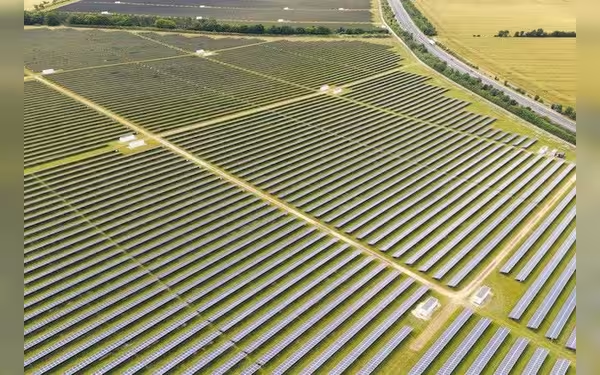Saturday, November 16, 2024 07:36 PM
Solar Power Surpasses Wind Energy in Record Duration
- Solar power outpaces wind energy since May 2023.
- Solar generation expected to rise further in 2024.
- Wind energy likely to reclaim dominance in winter months.
 Image Credits: tribune_pk
Image Credits: tribune_pkSolar power has outpaced wind energy since May 2023, marking a significant shift in renewable energy generation.
In recent months, the world has witnessed a remarkable shift in the landscape of renewable energy generation. Solar power has officially outpaced wind energy, marking a significant milestone in the global energy sector. Since May 2023, solar farms have generated more electricity than wind farms, creating a record-breaking duration for solar energy as the leading source of utility-scale renewable electricity worldwide.
According to data from the energy think tank Ember, solar electricity generation surpassed wind generation by 1.65 terawatt hours (TWh) in May and by an impressive 9.57 TWh in June. Although the data for July has yet to be released, it is anticipated that solar generation will show an even larger surplus, as July is typically the peak month for solar output in the northern hemisphere. Furthermore, August is expected to continue this trend, as it usually ranks as the second highest month for solar generation while wind generation tends to decline due to lower wind speeds.
Historically, solar power generation only exceeded wind generation in a couple of months in 2023, specifically in August and June. However, this sustained period of higher solar generation is unprecedented. As the seasons change, it is expected that solar output will decrease in the coming months, allowing wind energy to reclaim its position as the top renewable power source globally. This shift will be supported by increasing wind speeds as winter approaches in regions such as Europe, North America, and Northern Asia.
Looking ahead to 2024, projections indicate that total wind-powered electricity generation will likely surpass solar generation by at least 30%. This is primarily due to the peak wind generation period occurring during winter, when wind output can exceed solar output by more than double. For over two decades, wind farms have been the dominant source of renewable electricity, generating 2,311 TWh in 2023 compared to 1,632 TWh from solar assets.
Despite this, solar generation has been growing at a remarkable pace, doubling the growth rate of wind generation over the past five years. This rapid expansion can be attributed to the lower costs and quicker construction times associated with solar farms compared to wind projects. From 2018 to 2023, solar generation capacity increased by 188%, while wind capacity grew by 80% during the same period.
As we move into 2024, solar generation is expected to continue its upward trajectory, with a 26.5% increase in the first half of the year compared to the same period in 2023. In contrast, wind output has only seen an 8% growth. Key markets such as China, the United States, and Europe are driving this momentum, suggesting that solar generation levels will rise at a faster pace than wind generation in the foreseeable future.
However, it is important to note that wind farms have the advantage of generating electricity around the clock, unlike solar farms, which only produce energy during daylight hours. This characteristic will likely allow wind assets to maintain their status as the largest source of renewable electricity globally. Additionally, several large offshore wind projects are set to be completed in the coming years, which will further boost global wind generation.
While solar power is currently enjoying a moment in the spotlight, the dynamics of renewable energy generation are ever-changing. As solar generation continues to grow, it will likely challenge wind energy's dominance during the sunniest months of the year. However, the ability of wind farms to produce energy consistently throughout the day and night ensures that they will remain a crucial component of the global renewable energy landscape. The ongoing developments in both solar and wind energy will play a vital role in shaping a sustainable future for our planet.













